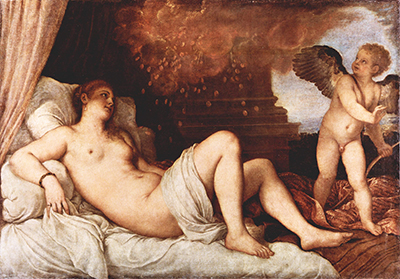1546 was an interesting year for Titian and his Danae because it was also the year of his first and only visit to Rome to visit one of his patrons - the Farnese family.
Cardinal Alessandro Farnese was the grandson of Pope Paul III. He also had a courtesan named Angela who was the subject of the painting which was intended for private viewing by himself alone. For political and ecclesiastical reasons, it has been suggested that the original painting was altered to reflect the myth of Danae rather than cause scandal for the church during the Council of Trent.
Pope Paul III, as well as excommunicating Henry VIII, was also the patron of Michelangelo and famously cajoled the artist to finish the Sistine Chapel. Interestingly, Michelangelo visited Titian in Rome in 1546 and viewed his Danae. He is said to have commented that it was ‘very nice’ but said later that Titian was incapable of drawing. This was a very mischievous barb which highlighted the different approaches of the Venetian and Florentine schools. Basically, Michelangelo sketched then painted, whereas Titian was more interested in colours and textures, painting on rough thick-weave canvases with spontaneity.
Ovid's myth of Danae was a subject matter that Titian would return to several times during this period. The 1546 version was the first and was alternatively entitled ‘Danae and the Shower of Gold’ and ‘Danae with Eros’. Danae, measuring 120cm x 172cm, is an oil on canvas, housed in the National Museum of Capodimonte, Naples. In this ‘Mannerist’ painting of the Later Renaissance period, the voluptuous figure of Danae lies reclined in a bed with crumpled sheets, midriff draped but her thighs are invitingly open suggesting that she has had or is about to have intercourse. Above her, Jupiter is depicted as a golden shower of coins emanating from a bronze cloud creating a luminescence on the body of Danae and to some extent on the figure of Eros who seems to be abashed by the eroticism of the scene. The clouds of Jupiter almost seem to be floating into the cave or temple (genie-like) from a bright gap in the walls of the temple / cave where the scene is presented.
The mixture of light and dark (chiaroscuro) and the different vibrancy of colours give an almost artificial effect to the painting. As regards the use of pigments, Titian’s list of important patrons put him in a very advantageous position which enabled him to buy the most expensive additions to his palette... lapis lazuli, azurite, yellow / orange arsenic-based paints and vermilion.
The development of Titian's reclining nude may have been based on drawings by Michelangelo, Corregio's Danae; his teacher, Giorgione's, Sleeping Venus and a development of his own painting Venus of Urbino. Titian's inventive approaches to subject matter and range of innovative artistic techniques inspired Caravaggio, Rembrandt, Rubens and Van Dyck. In 1907, Gustav Klimt used the same subject matter to create his own Danae.




